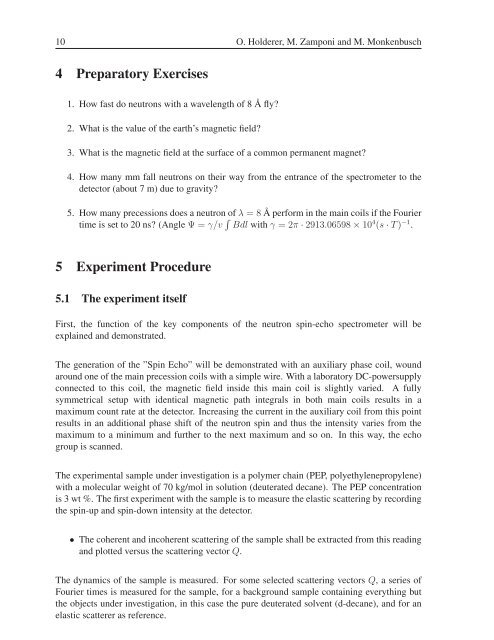Neutron Scattering - JUWEL - Forschungszentrum Jülich
Neutron Scattering - JUWEL - Forschungszentrum Jülich
Neutron Scattering - JUWEL - Forschungszentrum Jülich
Create successful ePaper yourself
Turn your PDF publications into a flip-book with our unique Google optimized e-Paper software.
10 O. Holderer, M. Zamponi and M. Monkenbusch<br />
4 Preparatory Exercises<br />
1. How fast do neutrons with a wavelength of 8 ˚A fly?<br />
2. What is the value of the earth’s magnetic field?<br />
3. What is the magnetic field at the surface of a common permanent magnet?<br />
4. How many mm fall neutrons on their way from the entrance of the spectrometer to the<br />
detector (about 7 m) due to gravity?<br />
5. How many precessions does a neutron of λ =8 ˚A perform in the main coils if the Fourier<br />
time is set to 20 ns? (Angle Ψ=γ/v � Bdl with γ =2π · 2913.06598 × 10 4 (s · T ) −1 .<br />
5 Experiment Procedure<br />
5.1 The experiment itself<br />
First, the function of the key components of the neutron spin-echo spectrometer will be<br />
explained and demonstrated.<br />
The generation of the ”Spin Echo” will be demonstrated with an auxiliary phase coil, wound<br />
around one of the main precession coils with a simple wire. With a laboratory DC-powersupply<br />
connected to this coil, the magnetic field inside this main coil is slightly varied. A fully<br />
symmetrical setup with identical magnetic path integrals in both main coils results in a<br />
maximum count rate at the detector. Increasing the current in the auxiliary coil from this point<br />
results in an additional phase shift of the neutron spin and thus the intensity varies from the<br />
maximum to a minimum and further to the next maximum and so on. In this way, the echo<br />
group is scanned.<br />
The experimental sample under investigation is a polymer chain (PEP, polyethylenepropylene)<br />
with a molecular weight of 70 kg/mol in solution (deuterated decane). The PEP concentration<br />
is 3 wt %. The first experiment with the sample is to measure the elastic scattering by recording<br />
the spin-up and spin-down intensity at the detector.<br />
• The coherent and incoherent scattering of the sample shall be extracted from this reading<br />
and plotted versus the scattering vector Q.<br />
The dynamics of the sample is measured. For some selected scattering vectors Q, a series of<br />
Fourier times is measured for the sample, for a background sample containing everything but<br />
the objects under investigation, in this case the pure deuterated solvent (d-decane), and for an<br />
elastic scatterer as reference.

















